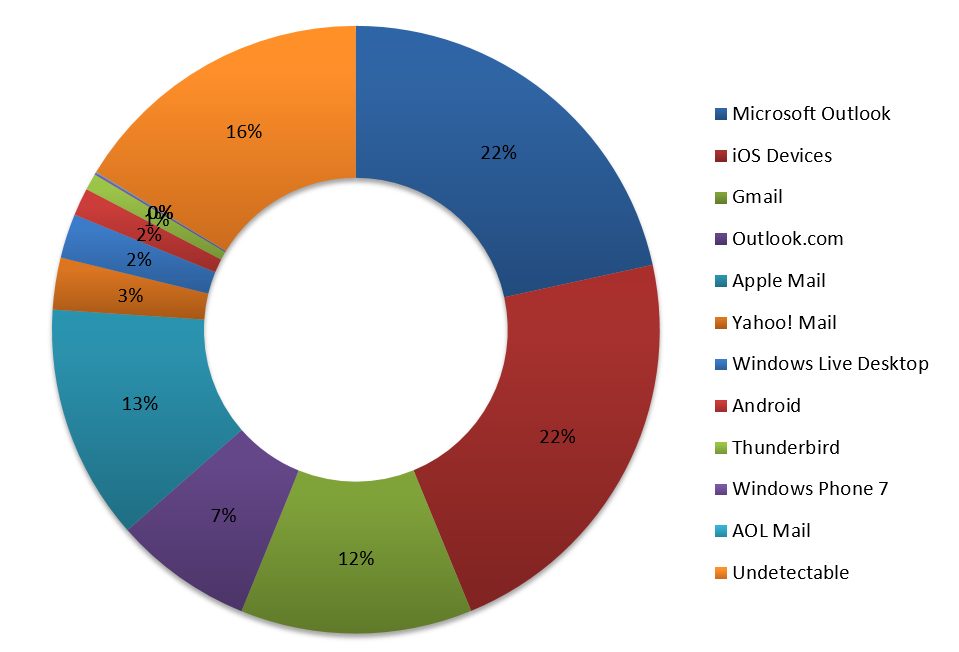Email Marketing Best Practices: Mobile First
Updated 15 January 2020 (Published 17 November 2015) by Miles in Digital Marketing
Between ourselves and our clients, we send a lot of marketing emails, email newsletters, EDM's and automated email (receipts, etc). We're talking in the thousands per week. Email marketing, done correctly, is a powerful method of engaging your existing clients, prospects, employees and other stakeholders.

However, with the increasing usage of smart phones for reading and composing emails, what was designed a few years ago really is out-of-date now. Let me explain why.
Australian mobile email usage statistics
Recently, we undertook some research into dozens of recent emails, and looked at the open rates, recipient email clients, and more. What we found is that mobile email use is growing, and quickly.
In fact, according to a random sample of 10,855 Australian email subscribers, the largest email client, coming in at 22.23%, was iOS devices (iPhone, iPad and iPod Touch).
This, along with other phone clients, shows that 1 in 3 emails are read on a small screen.

Australian Email Client Statistics, November 2015
Digging down deeper into our email data, we can see that these iOS devices are made up predominantly of iPhone, followed by iPad and a fraction of a percent on iPod Touch.
Australian iOS Email Client Statistics, November 2015
Nearly half of these devices are using the latest version of Apple Mail, and more than a quarter on the previous version. The remaining 24% of Apple Mail users are on earlier version, as shown below.
Australian Apple Mail, November 2015
Moving over to the second biggest email client, Microsoft Outlook, and we see that Outlook 2010, although 5 years old, still holds more than half the Outlook market. The newer version, Outlook 2013 comes in on second place at 22% as shown below.
Australian Microsoft Outlook Statistics, November 2015
What all of this tells us is that we can never assume that your recipients are viewing your emails on a large screen. To ensure your campaign is a success, we need to design all email marketing using a 'mobile first' mentality.
Tips on designing emails using a mobile first mindset
So, how do you use email marketing and ensure it is readable on a mobile device? Here are our six tips that will help you.
Include a link at the very top of the email that links to a web-based version of your newsletter or email.
This ensures that if the worst happens, and your audience receives a garbled email, they can at least get to a web version of the email, which will result in a better experience.
Less is more
Your email design should be a single column, and easily accommodate for smaller screens. The more cluttered, the harder to read on a small device.
Use large, clear calls to action
If you want someone to click on a link, remember they are likely using their fingers, not a mouse. Make those links big, and give them plenty of space from other links, to avoid user frustration.
Shorten those subject lines!
Less screen real estate, means what can be seen on a mobile device is incredibly short ranging between just 33 and 44 characters. Rather than use the subject line 'We have a great range of clothing items for your Unicorn, now on sale in Perth!' which will likely be cut after the word 'Clothing', you would be better saying 'Unicorn clothing on sale now!' a shorter (29 characters) but just as meaningful headline.
Be concise with content
The next time I see a 500 metre long email on my iPhone, I'll scream! Seriously - cut down the length, and link back to your website if you must. But don't make me scroll forever on my phone.
Keep images to a minimum
The problem with images in emails is not everyone will see them. In Apple Mail, images are turned ON by default, which is fine, however in Outlook, images are typically hidden. This leaves big white gaps in your emails, if a user doesn't click the 'images on' dialogue.
Images off in an email
A few general email marketing tips
Don't spam!
In Australia, we are strictly governed by the Australian Spam Act 2003. In simple terms, unless you have specific evidence that a subscriber has requested to be on your email list, then you can't email them. For a detailed version, see this guide.
Be frequent, but not annoying
In most cases, a monthly or bi-monthly email is best. In a small amount of cases, weekly may be OK, and very rare cases (such as breaking news digests) daily is fine. Leaving your list quiet for longer than three months means your subscribers will be going cold, and will likely forget their subscription.
Use an email marketing platform
Sending bulk email via your own computer is a very bad move. You'll find it will slow down your office emails, and many of the emails will likely never be delivered. Always use trusted email marketing software for best results and high deliverability.
Consider your audience
Not so much mobile related, as general good practice. Never send email marketing that doesn't give your readers something interesting. If it only interests you, then it's likely to switch off your subscribers, who will click that unsubscribe link pretty fast.
Summary
Taking care with your email marketing will ensure it can be read by your entire audience, not just a small portion. Keeping a mobile first approach to your emails, will ensure the widest readership and most chance of your recipients buying your product or visiting your website.
Good luck with your mobile email marketing!


